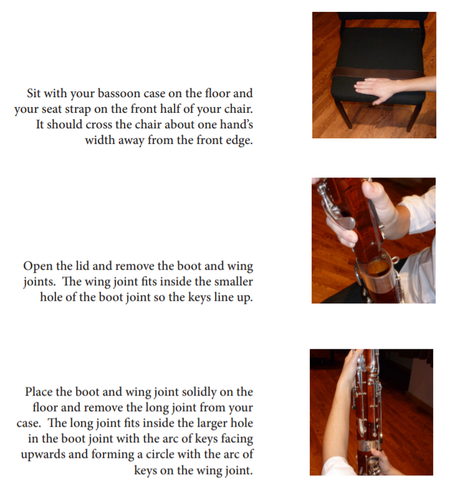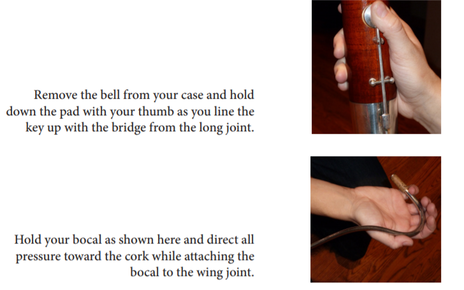Bassoon joints can go by many names in many different methods or texts. Here are the pieces in order of air direction:
One initial barrier with bassoon assembly is understanding which piece goes in which direction. Remember, the instrument is conical, which means that the bore gets gradually larger as the air gets closer to the bell - the joints will only fit in one end.
Pro-tip: Remember where the pieces were in the case as you take them out! It might be a good idea to take a picture of the instrument in the case for a reference when you disassemble to pack up.
Some key things to look for:
- Reed - made of wood, copper wires, and thread or glue around a round opening that fits around the...
- Bocal - made of metal, often silver plated nickel, with a cork end that fits into the...
- Wing Joint - also known as the tenor joint, has two or three open tone holes that face away from the body as a cork or string wrapped tenon fits into the...
- Boot Joint - double bored with a metal end cap protecting the U-bend where the air changes direction, as a very prominent round thumb key known as the "pancake key" that faces the body and a wood receiving joint to insert the...
- Long Joint - the longest joint, includes several long rods and bridge keys and four long left hand thumb keys that face the body and a cork or string wrapped tenon that fits into the...
- Bell - the final joint, includes only the pad for the lowest B-flat, and capped with either a white (German-style) or metal (French-style) ring.
One initial barrier with bassoon assembly is understanding which piece goes in which direction. Remember, the instrument is conical, which means that the bore gets gradually larger as the air gets closer to the bell - the joints will only fit in one end.
Pro-tip: Remember where the pieces were in the case as you take them out! It might be a good idea to take a picture of the instrument in the case for a reference when you disassemble to pack up.
Some key things to look for:
- the left hand thumb keys on the long and wing joints will form a circle (picture 3 below)
- the bell has a bridge that will engage with its counterpart on the long joint (picture 4 below)
Check-In:
Using your own words and at least one analogy appropriate for elementary aged students, describe how to assemble the bassoon.

